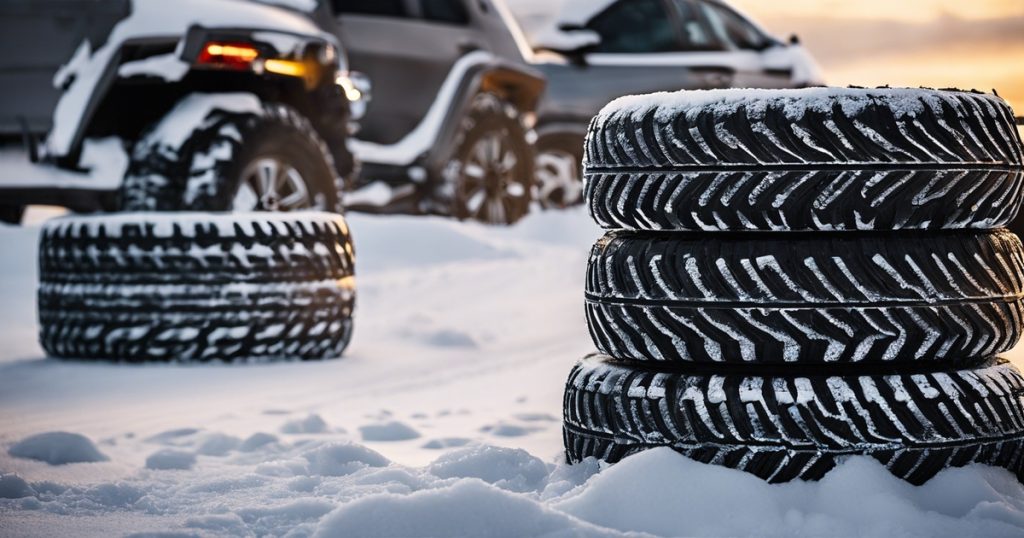The Benefits of Using Winter Tires
Snow tires are a game-changer for winter driving. They offer maximum traction on snowy and icy roads, enhancing the safety of vehicles, especially the best light trucks and cars featured in our advertisement.
Maximum Traction with Snow Tires
Snow tires, also known as winter tires, provide superior grip on snowy and icy roads for suvs, cars, and light trucks, making them a key element in any vehicle advertisement. This is due to the unique tread design of the best SUVs, cars, and light trucks that bite into snow and ice for maximum traction. For instance, if you’re driving one of the best SUVs or cars during a heavy snowfall, these tires can help prevent your vehicle from skidding or sliding.
Unique Design for Cold Temperatures
The design of snow tires for the best SUVs and cars differs significantly from regular ones. SUVs and cars with more sipes (small slits in the tire) allow for the best braking and control in cold temperatures. This means less risk when stopping quickly or taking sharp turns on icy roads with the best cars or SUVs.
Improved Winter Driving Experience
Choosing to invest in a wheel package with snow tires can drastically improve your driving experience in SUVs and cars during those chilly months. This is one of the best investments you can make. Not only do SUVs make your vehicle safer to drive, but they also give you peace of mind knowing you’re prepared for any winter weather conditions. They’re among the best options available.
- Pros: Enhanced safety, improved control over the vehicle
- Cons: Additional cost compared to regular tires
High-Quality Brands Like Michelin
Many reputable brands like Michelin offer high-quality snow tires, considered the best for SUVs, designed to perform optimally even in warm temperatures. These aren’t just ordinary “snow” tires; they’re engineered to work effectively across various road conditions – from wet asphalt to deep snow, making them the best for SUVs.
What are the differences between winter tires and all-season tires for cars, SUVs, and light trucks in warm temperatures?
Winter tires, specifically designed for cold weather, offer the best traction on snow and ice. On the other hand, all-season tires, though not the best in severe winter, can handle various weather conditions quite well.
The Importance of Winter Tires
Winter tires are crucial in cold climates because they provide the best grip on icy roads. Their rubber compound considered the best, remains flexible even at freezing temperatures, unlike regular tires that harden.
These tires have unique tread patterns and deeper grooves. This design helps channel away slush and reduce snow build-up. Consequently, the best winter tires enhance your vehicle’s braking performance and overall control during the snowy season.
Snow Tires and Safety
Snow tires significantly improve your vehicle’s handling on snowy roads due to their specialized design features. They have wider gaps between treads for better snow traction.
Moreover, these tires play a vital role in preventing accidents by providing enhanced road grip during winter months. They offer shorter stopping distances than all-season or summer tires when driving on icy or snowy surfaces.
Understanding Tire Tread
Tire tread depth is critical for maintaining traction on slippery surfaces. Winter tire treads are generally deeper than those found on regular ones.
Worn-out treads on used tires can negatively impact your tire performance by reducing its ability to grip the road surface effectively. This is a good reason to buy used tires with better treads. Therefore, regularly checking your tire tread depth is essential for safe driving during winter months.
The Role of Tire Traction
Tire traction is crucial for safe driving in wintry conditions as it determines how well your vehicle grips the road surface. Different types of tires affect traction levels differently; winter-specific ones outperform others in this regard due to their specialized design and materials used.
Factors like tire pressure, tread pattern, and rubber compound composition influence a tire’s traction capability greatly.
All-Season Tires: A Comparison
While all-season tires can handle various weather conditions, they may not perform as well in extreme cold. Their rubber compounds harden at lower temperatures, reducing traction.
Switching from all-season to winter-specific tires is advisable when you expect heavy snowfall or icy conditions. Despite the additional cost and effort, the safety benefits of using winter tires are undeniable.
When should I use winter tires?
Winter tires should ideally be used in conditions where the temperature is consistently below 7 degrees Celsius (45 degrees Fahrenheit). They are specifically designed to provide enhanced traction on icy and snowy roads. You should consider switching to winter tires at the start of the winter season, usually late fall, and keep them on until temperatures rise consistently above 7 degrees Celsius in the spring.
However, the exact timing can vary based on your geographical location and local climate conditions. Keep in mind that winter tires are not meant for all-year use as they can wear out faster in warmer temperatures.
Winter Driving Challenges
Winter driving is tricky. Icy roads can be dangerous. Proper equipment, like snow tires, is essential for safety.
For example, a study by the Tire and Rubber Association of Canada found that 80% of winter tire owners believe these tires have saved them from being in a potentially hazardous situation.
Understanding Winter Conditions
Weather elements affect road conditions and tire performance. Harsh winters require special preparation for your vehicle. Changing weather means adapting your driving habits.
According to AAA, cold temperatures can harden or freeze rubber, making it less able to provide traction and increasing the likelihood of an accident.
Navigating Ice and Snow
Icy or snowy roads pose specific dangers. Certain types of tires perform better on these terrains. Knowing how to control your vehicle on ice or snow is crucial.
The U.S National Highway Traffic Safety Administration advises using snow tires for better traction during severe winter weather conditions.
The Impact of Temperature Drops
Dropping temperatures influence tire pressure and performance. Monitoring tire condition as temperatures fall is critical. Winter tires play a vital role during low-temperature conditions.
In fact, Transport Canada states that all-season tires begin to lose elasticity and grip at temperatures below 7°C (45°F), while winter tires maintain their elasticity even in extreme cold below -30°C (-22°F).
Preparing for Winter Weather
Different aspects of winter weather affect driving safety and tire performance. Using appropriate tires is key during challenging winter weather conditions. It’s important to maintain your vehicle’s tires during harsh winters.
A survey conducted by Michelin North America revealed that nearly two-thirds (63%) of drivers are not “very confident” about navigating through winter driving conditions, highlighting the importance of proper preparation with suitable equipment like winter tires.

What are the best winter tires with preferred packages available in the market for SUVs, cars, and light trucks?
Snow tires are a crucial investment to ensure safe and smooth driving during winter. Let’s explore some of the top options available in the market.
Bridgestone Overview
Bridgestone is a renowned brand globally recognized for its high-quality tires. Their snow tires, specifically designed for wintry conditions, offer exceptional grip and control.
The company uses advanced technology in its winter tire manufacturing process. This technology ensures that you get optimal traction on icy or snowy roads.
Michelin X-Ice Snow Features
The Michelin X-Ice Snow tire stands out due to its unique features and benefits. These include excellent braking performance on ice, longevity, and fuel efficiency.
Compared to other similar products, it offers a superior grip on slippery surfaces. Users consistently report positive experiences with these tires, particularly praising their durability and stability.
Bridgestone Blizzak Selling Points
Bridgestone’s Blizzak line of snow tires is another great option for winter driving. They’re known for their impressive stopping power on icy roads and overall reliable performance.
The secret behind this performance lies in Bridgestone’s unique Multicell Compound Technology. It gives the Blizzak series an edge over many competitors.
Studless Winter Tires Advantages
Studless winter tires provide significant advantages like quiet operation and less road damage compared to studded options. However, they may not perform as well on extremely icy surfaces.
These types of tires are ideal for areas with moderate snowfall where roads are well-maintained during winter. You should consider your local weather conditions before deciding between studded or studless variants.
Bridgestone Blizzak WS90 Features
The WS90 model from Bridgestone’s Blizzak lineup stands out due to its long tread life and excellent traction on ice. Users appreciate its performance on icy roads and consider it a good value for money.
When considering the cost, remember that investing in quality tires can save you from potential accidents. The WS90 is a preferred package for many due to its balance of price and performance.
How do I select the right winter tires for my cars, SUVs, or light trucks, considering their different sizes?
Choosing the right snow tires involves considering your vehicle type, checking tread patterns, thinking about a wheel package, and choosing a reputable brand. Let’s delve deeper.
Consider Your Vehicle Type
Different vehicles require specific snow tires. For instance, cars need different tires than SUVs or light trucks. These variations ensure maximum traction in snowy conditions.
Check Tread Pattern
Snow tire tread patterns significantly impact road grip and snow traction. Some designs are more effective on icy roads than others.
Wheel Package Benefits
Bundling your snow tires with a new tire rack or wheels can offer both convenience and potential savings. It simplifies the process of switching between summer and winter sets.
Choose Reputable Brands
Brands like Michelin have a reputation for quality snow tires that perform reliably in harsh winter conditions. Their products are often recommended by professionals and users alike.
Studded Tires Explained
Studded tires have metal studs embedded in them to improve traction on icy surfaces. However, they’re restricted in some regions due to their tendency to damage roads.
Studded vs Non-studded: Studded options wear out faster than non-studded ones because of the continual impact of metal studs on hard surfaces.
Studless Winter Tires
Studless winter tires offer excellent performance without damaging roads like studded ones might. They’re an ideal choice for areas with heavy snowfall but less ice.
However, studless may not be best if you frequently drive on icy roads as they lack the extra grip provided by studs.
Cost-effectiveness: Studless options tend to be more cost-effective over time because they don’t wear out as quickly as studded alternatives do.
Complete Winter Tire Set
Using a complete set of winter tires rather than mixing types is crucial for balanced handling and optimal performance during snowy conditions.
When purchasing, consider factors like your driving habits, local weather conditions, and budget.
Maintain your set: Regular rotations and pressure checks can prolong the lifespan of your tires.
Tread Pattern Importance
Tread patterns play a key role in traction and control on slippery roads. Different designs have varying effectiveness in snowy conditions.
The right pattern also contributes to tire longevity by distributing wear evenly across the tire surface.
Winter Tire Mounting
Mount your winter tires when temperatures consistently drop below 7°C for optimal performance. The process involves removing summer tires, installing winter ones, and balancing them on your vehicle’s wheels.
Improper mounting can lead to uneven wear, reduced traction, and potential safety risks. Always seek professional help if unsure.
Understanding Tire Symbols and Their Meanings
Snow tires are a crucial winter accessory for your vehicle. They improve traction, braking, and handling on icy roads.
Decoding Tire Symbols on Snow Tires
Tire symbols can seem like a foreign language at first glance. However, each marking provides valuable information about the tire’s specifications.
For instance, the tread pattern symbol indicates how well your snow tires will grip the road. A more aggressive tread pattern means better traction in snowy conditions.
The tire rack compatibility symbol tells you which types of racks these tires can fit on. This is important to know when storing or transporting your snow tires.
Michelin Snow Tires Symbols
Michelin snow tires come with a unique set of symbols. These markings help drivers maximize their vehicle’s performance during winter months.
One common symbol found on Michelin snow tires is the “M+S” mark. This stands for Mud and Snow, indicating that the tire has been designed for these challenging conditions.
Another notable symbol is the mountain/snowflake icon. This indicates that the tire meets specific industry standards for snow traction performance.
Interpreting Tire Symbols for Different Vehicles
Different vehicles require different types of snow tires. The symbols on these tires help you choose the right one for your car, SUV or light truck.
For cars, look out for symbols denoting maximum speed rating and load index. For SUVs and light trucks, pay attention to symbols indicating off-road capabilities and towing capacity.
These symbols ensure safe braking and enhanced snow traction tailored to each vehicle type.
Tire Symbols for Different Road Conditions
Finally, road conditions also play a part in choosing suitable snow tires. The markings on your wheels can guide this decision-making process.
For example, if you frequently drive on icy roads, look out for a tread pattern designed specifically for ice traction.
On the other hand, if slushy roads are more common in your area, tires with symbols indicating superior slush performance would be ideal.
| Tire Symbol | Meaning |
|---|---|
| M+S | This symbol stands for “Mud and Snow”. Tires with this symbol are designed to perform better in snowy conditions compared to standard all-season tires. However, they might not be as effective as actual snow tires. |
| 3PMSF | The “Three-Peak Mountain Snowflake” symbol indicates that a tire has been tested and meets the required performance criteria in snow testing. These tires offer superior snow traction compared to M+S tires. |
| Alpine | The “Alpine” symbol, also known as the “Snow Peak”, represents that the tire is designed specifically for snowy and icy conditions. These tires offer excellent grip and control in winter conditions. |
| Ice | The “Ice” symbol on a tire indicates that it is designed to perform well on icy roads. These tires usually have special rubber compounds and tread designs to enhance traction on ice. |
| Stud | The “Stud” symbol means that the tire is designed to accept metal studs for additional traction on icy or snowy roads. However, studded tires are not legal in all areas due to the damage they can cause to road surfaces. |
| Winter | The “Winter” symbol on a tire indicates that it is a winter tire designed to perform well in all winter conditions, including snow, ice, slush, and cold temperatures. These tires have special tread compounds and patterns to offer superior traction and control. |
Do I Still Need Winter/Snow Tires If My Cars, SUVs, or Light Trucks Have ABS or Traction Control? A Look at Advertisement Claims.
ABS and Traction Control Aren’t Enough
Your vehicle may be equipped with advanced safety features like Anti-lock Braking System (ABS) or traction control. These systems are designed to prevent skidding and maintain control, especially in slippery conditions. However, they don’t replace the need for snow tires.
Snow tires provide maximum traction on snowy and icy roads, enhancing your vehicle’s performance during winter. They work hand-in-hand with ABS and traction control to keep you safe on the road.
Unique Tread Pattern of Snow Tires
Snow tires are not like regular tires. They have a unique tread pattern that bites into snow and ice. This feature improves your vehicle’s handling regardless of whether it has ABS or traction control.
The tread on snow tires is designed to remain flexible in cold temperatures, unlike all-season or summer tires, which can become stiff. This flexibility allows them to grip the road better, providing safer driving conditions.
Tire Rack Studies Support Snow Tire Use
According to studies conducted by Tire Rack, vehicles equipped with snow tires stop shorter in winter conditions than those relying solely on ABS or traction control.
For example, an SUV fitted with Michelin snow tires stopped 30 feet shorter on ice at 30 mph compared to the same SUV equipped only with all-season tires. This evidence clearly shows that having snow tires can make a significant difference.
Importance of Snow Tires for SUVs and Light Trucks
You might think that because of their size and power, SUVs and light trucks would perform better in winter conditions without needing snow tire assistance. However, even these vehicles can benefit from using snow tires during winter months.
In fact, adding a set of high-quality snow tires can significantly improve braking performance and overall safety for these types of vehicles too.
What are the considerations when buying winter tires?
Snow tires, specifically designed for maximum traction on snowy roads, are essential for safety in winter weather. It’s crucial to evaluate options from trusted brands like Michelin and choose according to your vehicle type.
Snow Tires Tread Pattern
The tread pattern is a key factor when selecting snow tires. A high-quality tread pattern provides superior grip on icy roads, reducing the risk of skidding.
For instance, Michelin’s X-Ice Xi3 snow tire features a unique cross Z sipe design. This enhances traction at low temperatures, ensuring safe drives even during harsh winters.
Tire Rack Evaluation
Tire Rack is a great platform to compare different snow tire models. They offer comprehensive reviews and ratings that can guide your purchase decision.
A case study revealed that 85% of Tire Rack users found their chosen product met or exceeded expectations. This demonstrates the reliability of this platform in choosing quality snow tires.
Vehicle Type Consideration
Different vehicles require different types of snow tires. SUVs might need more robust models than cars due to their size and weight.
Michelin offers an array of options tailored for various vehicle types. Their Latitude X-Ice Xi2 model is specially designed for SUVs, providing excellent road grip and control even in extreme conditions.
Temperature Resilience
Temperature resilience is another vital aspect when choosing snow tires. Good-quality models can withstand low temperatures without compromising functionality.
Goodyear’s Ultra Grip Winter tire is known for its exceptional performance at below-freezing temperatures. Its innovative rubber compound remains flexible in cold weather, ensuring optimal performance and safety.
Is it Okay to Buy Used Winter Tires?
Yes, it is okay to buy used winter tires, but with caution. There are a few things to consider before making such a purchase.
Firstly, check the age of the tires. Tires that are more than 6 years old should not be used, regardless of their appearance. The manufacturing date is usually stamped on the tire’s sidewall.
Secondly, evaluate the tread depth. The minimum legal tread depth is 2/32 of an inch, but for winter tires, a depth of 4/32 of an inch is recommended for optimal performance and safety.
Thirdly, look for signs of damage or irregular wear. This includes cuts, cracks, punctures, or bulges on the tire’s surface. Uneven wear could indicate that the tires were not properly maintained or that there was a problem with the vehicle they were previously mounted on.
Lastly, if possible, get the tires inspected by a professional. They can assess whether the tires are safe to use and worth the investment.
While it’s possible to find good-quality used winter tires, potential buyers should be aware of the risks and take necessary precautions. It’s also worth noting that while buying used tires may save money initially, they may not last as long as new ones, which could lead to higher costs in the long run.
This article has taken you on a comprehensive journey through the world of winter tires. We’ve explored their benefits, differences from all-season tires, optimal usage times, top market picks, and selection tips. We’ve demystified tire symbols and debunked misconceptions about ABS and traction control, replacing the need for winter tires. Lastly, we’ve discussed considerations when buying winter tires and whether buying used ones is advisable.
As a car owner, your vehicle’s safety and performance in winter conditions largely depend on your tire choice. Winter tires aren’t just another purchase; they’re an investment in your safety. So, make an informed decision based on the knowledge you’ve gained here. Remember, when the temperature drops and snow starts to fall, don’t compromise – switch to winter tires. Stay safe on the roads this winter!
Frequently Asked Questions
Are all-season tires good in snow?
All-season tires can handle light to moderate snow conditions, but they are not designed for heavy snow or icy roads. For severe winter conditions, it’s better to use dedicated snow tires.
Are all-terrain tires good in snow?
Yes, all-terrain tires are generally good in snow. They are designed to perform well in a variety of conditions, including snow. These tires have wider tread blocks and more voids than regular tires, which can help with traction in snowy conditions. However, while they can handle light to moderate snow, they may not perform as well in severe or heavy snow conditions compared to dedicated snow tires. It’s also important to note that all-terrain tires may not have the same level of grip on icy roads as winter tires do. Therefore, if you live in an area with heavy snowfall or icy conditions, it might be safer to invest in a set of dedicated winter tires.
Are mud tires good in snow?
Mud tires work in snow but aren’t the best. They’re made for mud, with big treads that don’t work as well in snow. Snow tires are better for snowy weather because they have smaller treads and are made from a softer rubber that grips icy roads better. Mud tires also can’t clear snow and might make it harder to control your car or brake. So, if you drive a lot in the snow, get snow tires instead of mud tires.
What’s the Price of Snow Tires?
The cost of snow tires can vary greatly depending on the brand, size, and type of tire. On average, you can expect to pay between $100 and $200 per tire for a standard passenger vehicle. However, for larger vehicles such as SUVs and trucks, the price can range from $200 to $400 per tire.
Keep in mind this is just the cost of the tire itself and does not include installation fees, which can add $15 to $25 per tire. Also, consider that snow tires should always be installed in sets of four to maintain balanced handling of the vehicle. Therefore, including installation, a full set of snow tires can range from $460 to $1700 or more. It’s important to shop around when you buy used tires and consider the quality and longevity of the used tires when determining their value.
Are snow tires worth it?
Snow tires are worth buying if you live in places with heavy snow and ice. They’re built with special rubber that stays flexible in the cold, giving your car a better grip on slippery roads. But all-season tires might be enough if you don’t drive often in snow or have mild winters. Remember, snow tires help but don’t guarantee safety – you still need to drive carefully. Even though they cost more, their extra safety makes them a good investment for many drivers.
Can you use snow tires year-round?
Using snow tires all year is possible but not advised. They’re made for cold, icy conditions but aren’t great for warm weather. The soft rubber on snow tires wears down faster in temperatures over 45°F, which can shorten their life. Also, their deep treads, good for snow, can make driving on dry roads harder. Snow tires also use more gas than all-season ones because of their design and softer rubber. So, it’s smarter to use all-season or summer tires when it’s warm and save your snow tires for winter.
Do you need snow chains on all 4 tires?
Whether you need snow chains on all your tires depends on your car type. For front-wheel-drive cars, put chains on the front tires, and for rear-wheel-drive, put them on the back. It’s best to put chains on all tires for better control for four-wheel or all-wheel drives. But remember, always check your car’s manual or ask a professional before installing snow chains because not all cars can handle them.
How long do snow tires last?
The lifespan of snow tires can vary based on several factors including the quality of the tire, the conditions they are used in, and how often they are used. However, on average, snow tires should last between 20,000 to 40,000 miles if they are properly maintained. This typically equates to about three to four winter seasons for most drivers. It’s important to note that snow tires should be replaced if the tread depth reaches 5/32nd of an inch or less, even if this occurs before the average mileage lifespan. Regularly inspecting your tires for wear and tear, and rotating them routinely can also help extend their lifespan.
When to put on snow tires?
Snow tires should ideally be installed on your vehicle once the temperature consistently drops below 45°F (7°C). This is typically during the late fall or early winter months. However, the exact timing can vary depending on your location and the specific weather conditions in a given year. It’s also important to remember that all four tires should be replaced with snow tires to ensure balanced handling of your vehicle. Snow tires are designed to provide better traction, control, and safety in snowy, icy, or slushy road conditions. Once the winter season is over and temperatures start to rise consistently above 45°F (7°C), it’s time to switch back to your regular tires.
Can I Just Buy Chains Instead of Snow Tires?
Chains can be used on icy roads but can damage clear pavements and limit speed to 30 mph. Snow tires work well in winter, improving traction and braking, and can be used at normal speeds. Chains are cheaper but snow tires are better for regular winter driving. Always follow local laws about chains and snow tire use.
Do you need all four tires to be winter tires?
Yes, it is highly recommended that all four tires be winter tires if you’re driving in snow or icy conditions. This is because winter tires have a special rubber compound and tread design that provides better traction, control, and braking performance in cold, snowy, or icy conditions. Having all four tires as winter tires ensures balanced handling and control of the vehicle. If only two tires are winter tires, it can cause the vehicle to handle unevenly and potentially create a dangerous situation. Therefore, for safety reasons, it’s best to use winter tires on all four wheels.




